After 85 years of building Miami’s Black middle class, longshoremen face biggest crisis yet
Any day of the week in the pre-pandemic, pre-dawn hours, the corner of Northwest 8th Street and Northwest Second Avenue was bustling with sleepy crowds, illuminated only by street lights and the glow inside the corner store. By 7 a.m., hundreds of men and women would make their way inside the International Longshoremen’s Association Local 1416 building in Overtown as the sun rose. Most were union members, nearly guaranteed a full-day’s work of loading and unloading goods and luggage from cargo and cruise ships at PortMiami. Others were day laborers, hoping to catch a shift and one day earn a coveted union card.
Today, the union hall is much quieter. There are no pre-dawn crowds, just small groups of masked men and women doing their best to stay six feet apart while they wait in line for temperature checks at the hall door. No one with fewer than three years of seniority bothers to come; there isn’t any work for them. The COVID-19 pandemic has reduced working hours for cruise ships from 90,443.50 in January 2020 to just 3,878 last month.
Since its founding 85 years ago, the local longshoremen’s union has provided a dependable avenue to the middle class for Black Miamians willing do the mostly invisible, grueling work that makes PortMiami run.
Over the decades, the group has weathered segregation and automation, growing to nearly 800 members strong. Now facing a once-in-a-century pandemic, the longshoremen hope the ships return soon so they can get back to work.
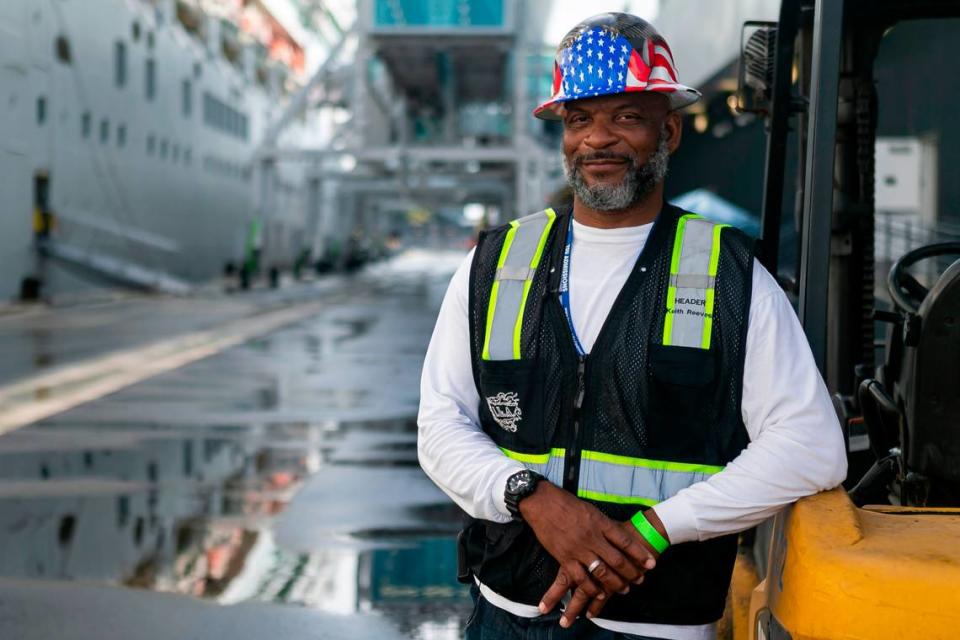
“We were doing so well until the pandemic came,” said Keith Reaves, 55, who began working as a longshoreman in 1992. “We basically built the port up; the longshoremen put a lot of hard work and dedication into it. And here we are today, we’re still surviving...We’re going to rebuild and get stronger and stronger.”
But that could take a while.
As the sun rose over Miami on a recent Tuesday, some 30 longshoremen inside the union hall bowed their heads for a prayer led by the assistant chaplain. Then Reaves, designated as a supervisor called a “header,” walked to the sliding glass window to get his “gang” — longshoremen lingo for work group — order sheet. During normal times, a cruise ship gang might have as many as 21 people; on this day, Reaves’ gang had just four, including him.
“We never know what’s waiting for us,” he said.
Reaves is part of a proud tradition that began back when cargo ships were a fraction of the size they are today and cruise ships had yet to line the pier. Founded by a group of 10 Black men in 1936, the longshoremen’s Local 1416 was one of the few labor unions that even allowed Black members. Before that, ship and dock owners regarded the Black longshoremen as expendable, paying them just $0.36 an hour, the lowest longshoremen wage in the country. It is the oldest Black union in the state.
The union was still building power in the mid-1940s, when Alfred Youmans, now 90, moved to Miami from South Carolina to find work. Back then, workers waited on the sidewalk on Biscayne Boulevard and 10th Street to pick up shifts paying 72 cents per hour; until 1955, there was no union hall. Youmans didn’t even know what a longshoreman was.
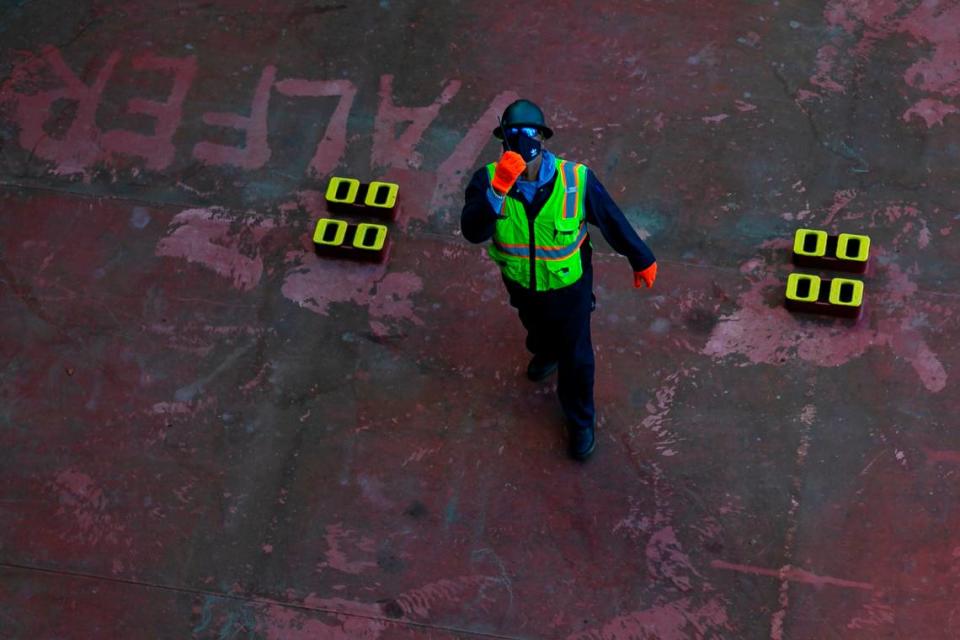
The 17-year-old would wait all day and all night for just 30 minutes of work, and then return to the same spot to wait again for the next vessel. If someone heard a ship was coming in, they kept that news to themselves, Youmans said, not wanting to give away an opportunity.
“Everybody was trying to catch a break,” he said. “You’re scared to go to sleep because they might hire more men. It was a thing that kept you alert. It wasn’t easy.” After two years of day laboring, Youmans joined the union in 1950.
Black empowerment
Until the mid-1960s, Miami establishments remained segregated, and the port was no exception. Longshoremen who worked in the 40s and 50s remember having to order lunch from the back doors of downtown restaurants, whose indoor tables were off-limits, and use “Colored Only” bathrooms and water fountains at some of the piers. Between shifts they would head to Overtown, then “Colored Town,” for a break or a bite to eat.
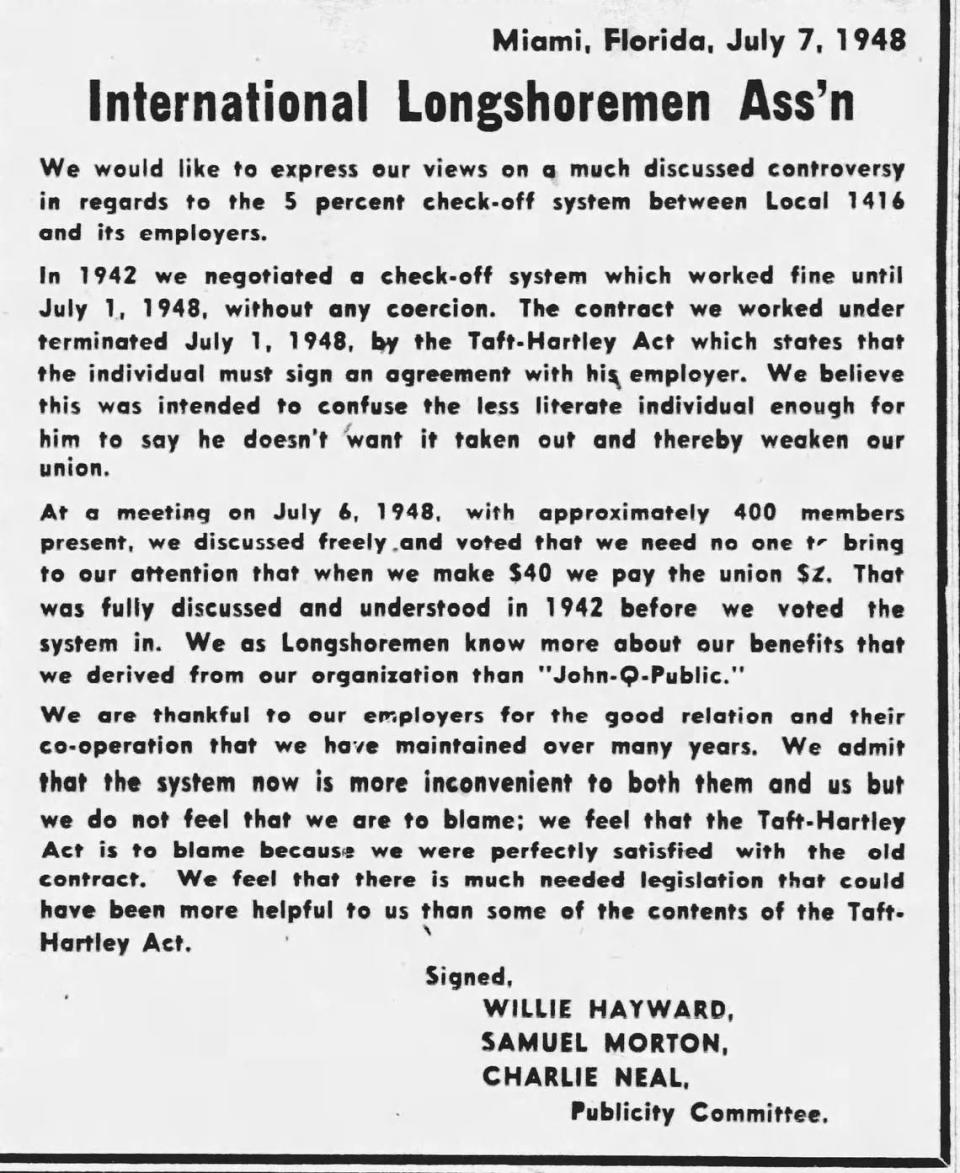
Despite Jim Crow laws, it didn’t take long for the union to gain political power. In 1948, Local 1416 took out an ad in the Miami Herald opposing the recently passed Taft-Harley Act, which allowed states to pass anti-union laws requiring employees to affirmatively agree to union representation. The longshoremen said they believed the act was intended to confuse the “less literate individual” into believing he’d be better off not represented by a union.
“We as Longshoremen know more about our benefits that we derived from our organization than ‘John-Q-Public’,” the ad read.
Local 1416 backed the candidacy of civil rights activist Lawson E. Thomas for judge of Miami’s Negro Police Court and writer Stanley Sweeting for constable in 1950; both became the first Black people to hold those positions. The group participated in local blood drives and spoke at new school dedications.
In 1956, when ships were turning away from Miami to avoid decaying port facilities at Bicentennial Park, Local 1416 President Judge Henderson urged the city to invest in the harbor, telling a Miami News columnist, “Miami could handle 100,000 tons more freight per year if we had a decent port. That would mean that much more work for my men. And the entire community would benefit because it’s cheaper to ship by boat than by rail or air.”
The campaign prevailed. In 1967, the city inaugurated modern port facilities on Dodge Island.
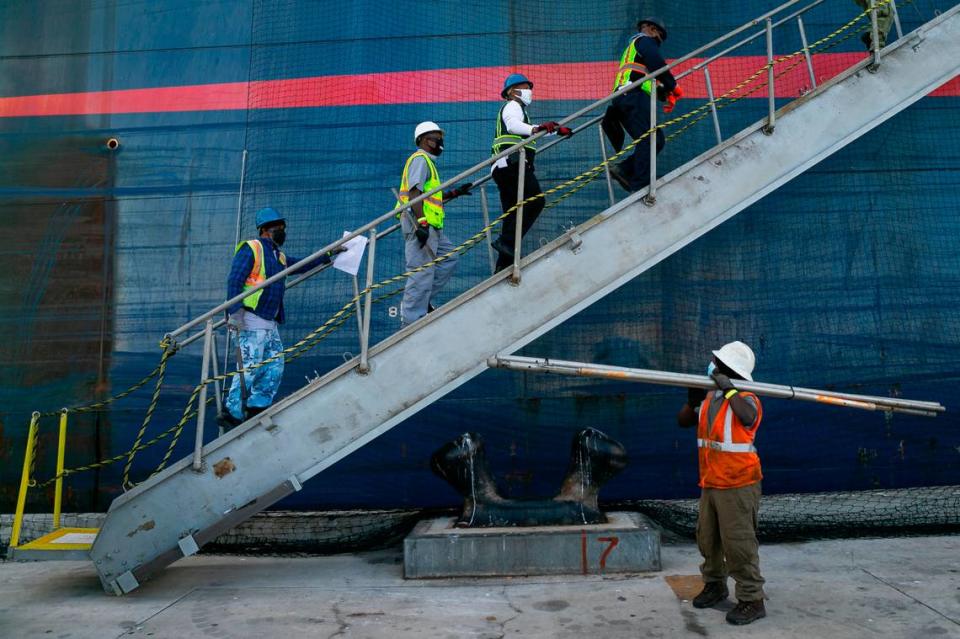
“It was the first effective political arm of Black people in Dade County,” said historian and Florida International University psychology professor Marvin Dunn, 80, whose father James Dunn, a Navy cook during WWII, worked as a longshoreman at PortMiami from the mid-1950s to the mid-1990s. “The longshoremen realized early on that they had power. If they stopped working, the country stopped functioning. Black empowerment became a reality among the longshoremen union.”
First and foremost, Local 1416 has always been about providing middle-class jobs. Today a starting wage for a longshoreman is $20 an hour. After six years of working at least 700 hours per year, the job pays $37 an hour.
Before moving to Miami to find better work, James Dunn was a migrant farm laborer. Marvin Dunn worked with his father picking fruits and vegetables as the family moved back and forth with the harvest from Central Florida to New York’s Long Island. When his father began working as a longshoreman at PortMiami, Marvin Dunn’s whole life changed. His father’s steady salary, health insurance and pension made it possible for the family to buy a home in Opa-Locka and for Dunn’s mother to give up cleaning white families’ homes.
“The longshoremen did that for my family, made our lives totally different from people who were also Black who didn’t have union protection and union benefits,” Dunn said.
For Reaves, the header, his first glimpse of the longshoremen came in the 1970s at the annual Martin Luther King Jr. parade. Hundreds of longshoremen marched in crisp white shirts and Lee’s overalls. He remembers thinking the group looked “like extraordinary guys,” the kind of guy he hoped to grow up to be.
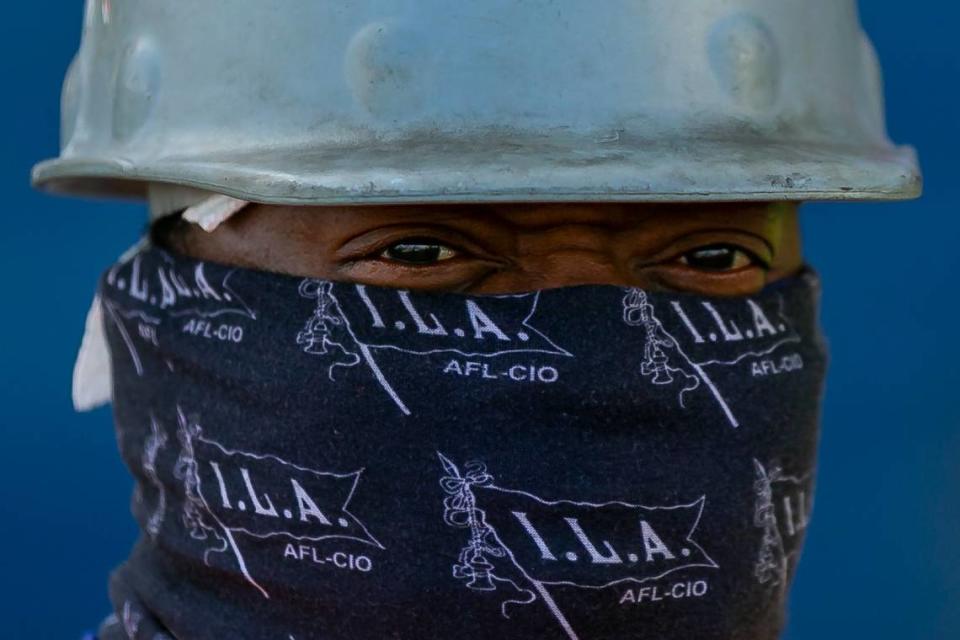
The same was true of Reggie Abel, 47, who first saw the longshoremen at the same parade a decade later. The Overtown native has been a member of Local 1416 since 2016.
“I used to see them coming here with the overalls,” said Abel. “You looked up to them, respected them, you knew they worked hard. I never knew what the longshoremen did, I just knew [the union] was respected.”
Abel rejoined society in 2006 after a 14-year stint in prison for armed robbery committed at the age of 18. He caught work — unsteady though it was — at construction and warehouse jobs, earning $11-$12 an hour. On the advice of his godfather, a longtime longshoreman, he gave working on the waterfront a try in 2014. It took him two years to become a union member.
“It’s a second chance,” he said. “This is the only job I’ve had where I look forward to coming to work. I have a decent home, something I never thought I could accomplish.”
“We don’t throw anyone away”
Providing a second chance to Black Miamians is central to the Local 1416 philosophy, said president Torin Ragin, 44. Members elected Ragin as the union’s fifth president last July.
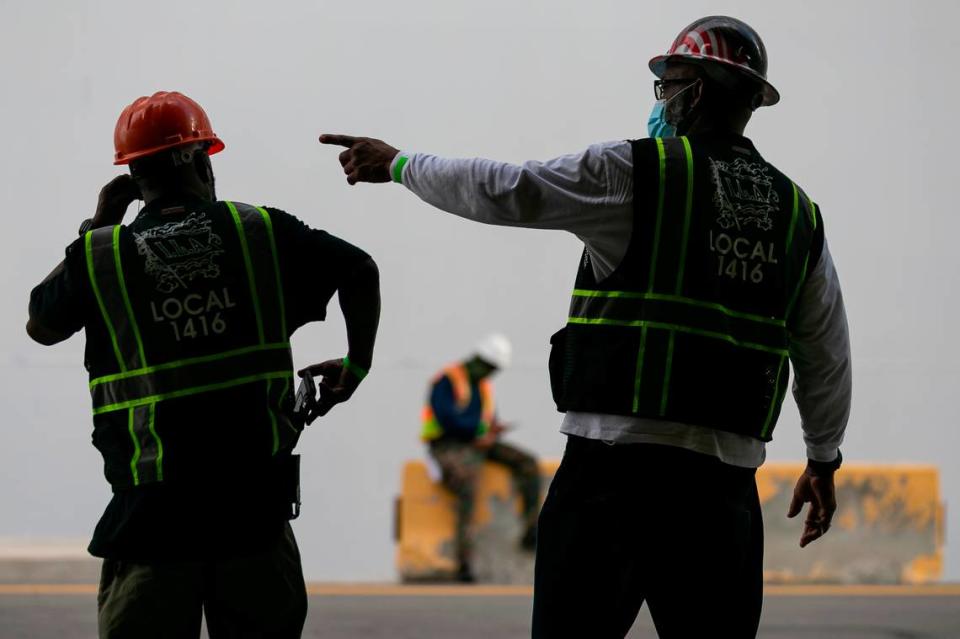
In 1977, Local 1416 successfully lobbied against a county commission proposal to only allow longshoremen to work at the port if they did not have felony convictions. In 1998, the Miami-Dade commission passed a similar, though narrower, law despite a lawsuit from Local 1416.
As long as someone is willing to do the work, there is a place for them, said Ragin.
“We don’t throw anyone away,” he said. “Our people have been disenfranchised and tossed aside for a very long time. And so as an organization, we want to make sure that we welcome people with open arms, the ones who are sincerely willing to work and to bring the right attitude to this organization.”
For all its virtues, the union’s past isn’t flawless. In 1953, 20% of the union — mostly Bahamians — backed an effort by the executive secretary to end then-president Judge Henderson’s tenure. Henderson — backed by the 80% who were African-American — sued and won. He remained president for several more years.
Dunn remembers the “interracial conflict” well. He overheard his father complain bitterly about Caribbean-born longshoremen taking work away from African-Americans.
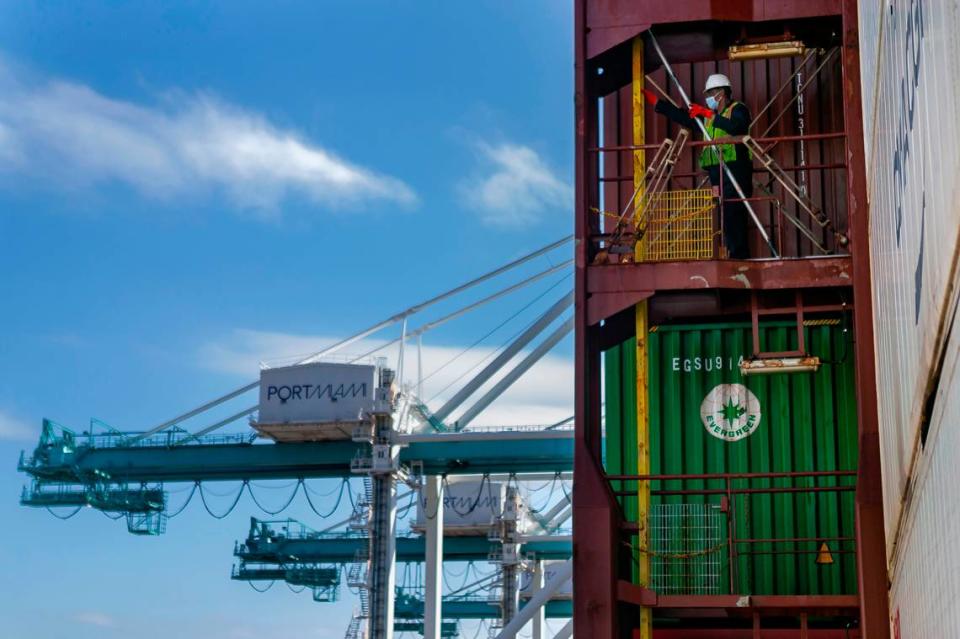
Today, if conflicts arise, longshoremen say they leave disagreements on the mainland side of the bridge.
“There’s a lot of guys who don’t like each other,” said John Ragin, 56, who started working as a longshoremen in 1983. “When we come on the job we take care of each other until we get back across the bridge. The work comes first.” John Ragin is the cousin of current president Torin Ragin.
Local 1416 also didn’t escape the corruption more popularly associated with the longshoremen unions in New York and New Jersey. In 1979, former Local 1416 president Cleveland Turner was convicted on racketeering charges after an FBI investigation found the union accepted illegal payments from a shipping company employee working as an undercover agent. Turner was re-elected before serving a prison sentence in the 1980s.
The union has also faced allegations of nepotism; it’s common for many members of the same family to join. In recent years, hiring has become more fair, newer longshoremen say, with more attention put on work ethic and less on connections.
“Here if you put in the hours, you can make it,” said Abel.
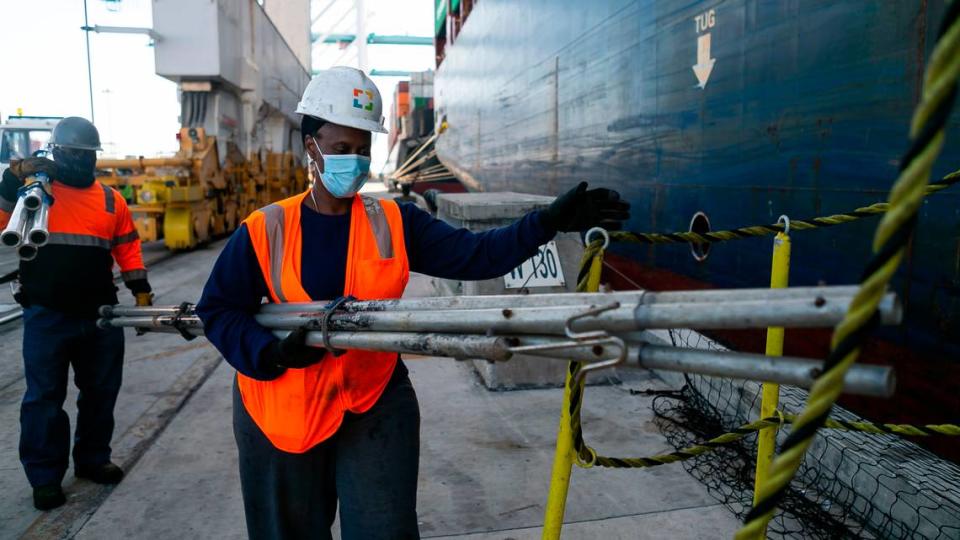
Back-breaking work
The work can be back-breaking, literally. Back and knee pain are so common that longshoremen don’t even mention them unless pressed.
On a recent Tuesday, Reaves and his gang of three men drive from the union hall to the Norwegian Cruise Line terminal, arriving by 8 a.m. Reaves prefers the bridge over the tunnel because of the “million dollar view,” his description of the landscape made up of PortMiami buildings, Biscayne Bay and surrounding islands.
Before COVID-19 paralyzed the cruise industry, Reaves oversaw the loading and unloading of as many as 35 trucks-full of goods during a single cruise ship’s stay. The pier was as busy as I-95, he said. Other longshoremen worked as porters, helping passengers and luggage on and off the ships.
The Local 1416 longshoremen work side by side with workers from Local 1922, Miami’s other longshoremen union. Local 1922 longshoremen are known as “checkers,” managing the administrative aspects of loading and unloading ships smoothly. In the 1930s, Local 1922 was referred to as the white longshoremen’s local, though the membership today is largely Hispanic.
Now, the cruise ships carry skeleton crews of only around 100 people — all workers — as cruises remain banned in the U.S., so Reaves never knows exactly what’s waiting for him when he arrives. It’s a lot of hurry up and wait.
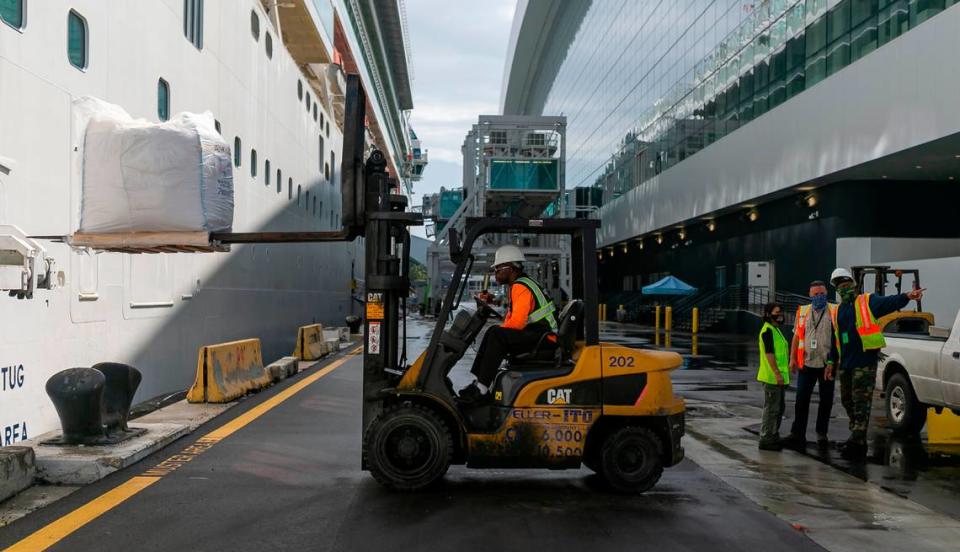
It’s 11:15 a.m. before Reaves and his men guide a truck into the terminal garage. When the trailer door opens, just five pallets of sand sit inside — a sad and striking contrast to the tightly packed trucks that were standard just a year ago. Using forklifts, the men lift the pallets off the truck, into the garage, then lower them down to the pier where an excited German Shepherd gives them a sniff. A door the size of a billboard on the side of the Norwegian Gem cruise ship opens up, and a masked crew member peers down. The longshoreman on the forklift raises each pallet into the bowels of the ship to be disinfected.
Reaves’ job for the day is done.
Cargo carries on
Far less has changed on the port’s cargo side. The most noticeable change: longshoremen and other workers now wear masks, which some say they’ll keep wearing even post-pandemic to block dust and soot. While cruise work hours were down 96% last month compared to the previous January, cargo hours only dipped seven percent, from 107,512.50 in January 2020 to 99,703.50 last month.
Unlike cruise ships, cargo ships don’t stick to regular schedules; depending on the load, longshoremen can work more than 24 wearying hours on a single vessel.
The cargo docks are located on the port’s east end, stacked with box cars and the cranes that hoist them. After passing through a cargo security checkpoint, workers park alongside the ships, don hard hats and reflective vests, and make their way to their designated posts. One group goes inside the ship, carefully snaking through narrow passages that divide the rows of containers to unhook those on the day’s work list.
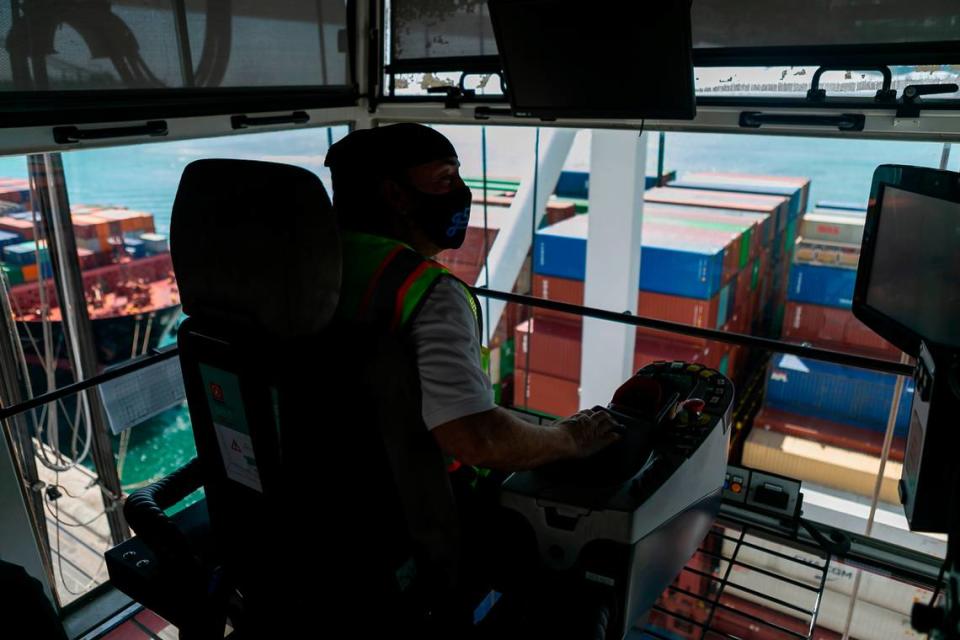
A crane operator enters a coffin-sized elevator that rises 200 feet into the air. The job requires all the precision of an arcade claw grabber — but with vastly higher stakes.
The operator — also a longshoreman — positions the crane over the ship, secures cables to the container, then moves the crane back over the pier and lowers the container 20 stories onto the back of an 18-wheeler truck. With every movement, the crane jerks slightly, the ground visible through the glass floor.
Longshoremen drive the container to a designated zone on the port and unload it, then return the truck to its position.
On the cargo side is Katrina Adams, 54, one of around just 30 longshorewomen. She’s been on the job since 1998, when she followed in her father’s footsteps. She has been able to raise her three kids as a single parent thanks to the job’s flexibility, working as much as she can on the days she’s available and taking days off that she needs.
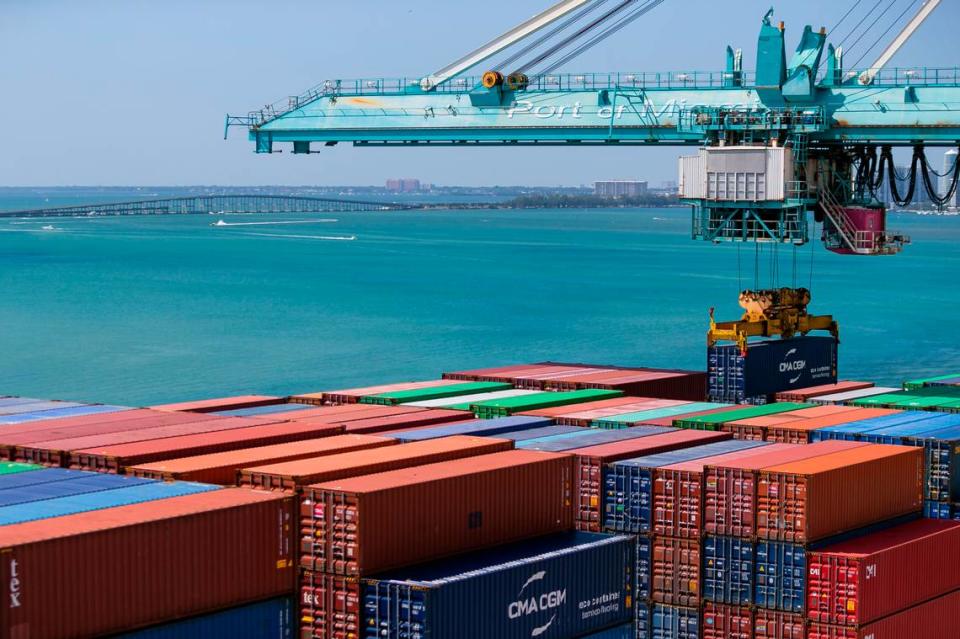
She prefers working the cargo side because she can keep to herself there.
“You don’t have to be with the public, the public is not allowed in this area,” she said. “I love what I do. It’s a challenge but I always believe with a man’s job, anything they can do I can do better.”
Whether its cargo or cruise goods, longshoremen spend most of the day on their feet. But as taxing as the work is today, old-timers say it’s nothing compared to the pre-forklift, pre-container era.
“Steel, lumber, cement: all of that was lifted by hand,” said Youmans, who began in 1948. “It was hard on your all over. There was no easy work on the port then.”
Moses Ragin, 75, who joined in 1967, remembers loading groceries onto Carnival Cruise Line’s Mardi Gras ship by hand in 1972. Moses Ragin the ungle of current Local 1416 president Torin Ragin.
“You feel tired most of the time, tired and dirty,” he said.
Machines brought much needed relief over the decades.
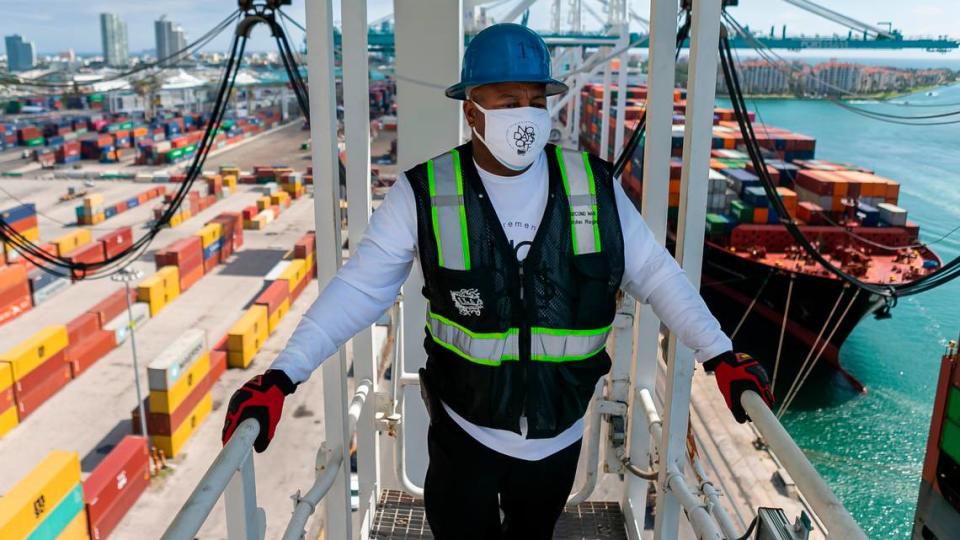
“You were glad to see that machine,” said Youmans. “You’d be so sore you could hardly sleep when you did get home. You were glad to see that forklift.”
But automation also stirred fear. Former Local 1416 president Clarence Pittman, who served in the role from 1982 to 2013, told the Miami Herald in 1985 that he worried the workers would get too weak and ultimately be replaced by machines. Ships that once required 300 workers suddenly used just one crane, five hours and 25 workers.
“I’ve seen men all dressed in white, and eight hours later, they’ll still be clean and pretty,” he said. “I don’t want to say it, but it may be a dying profession.”
He was wrong. Longshoremen have adapted, getting certified to operate every new machine. That kind of resilience pulled them through economic downturns before, and Ragin said it will pull them through this one.
“It’s like the old guys used to say: Keep coming. And so you keep coming,” he said.
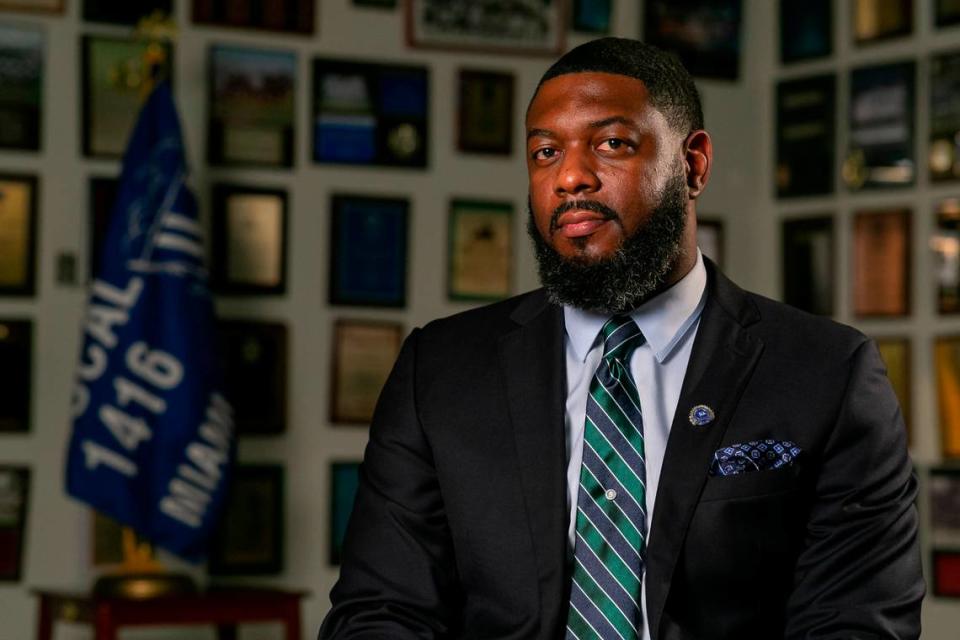
A permanent mark
But being a longshoreman is more than just a job. It’s a community.
Every Saturday and Sunday until the COVID-19 pandemic hit, Moses Ragin, who retired in 2008, would sell around 100 of his sweet potato, pecan, and coconut pies to hungry former colleagues at the union hall. He hasn’t been since March.
“I miss going there, but my health comes first,” he said.
For several years after Youmans retired in 1988, he would wake up before the sun thinking he still had to go to work.
“It’s a place that you never fully forget,” he said. “You always think about the fellows with you, guys you worked with every day, it is a swell feeling. Every day there was something new to learn.”
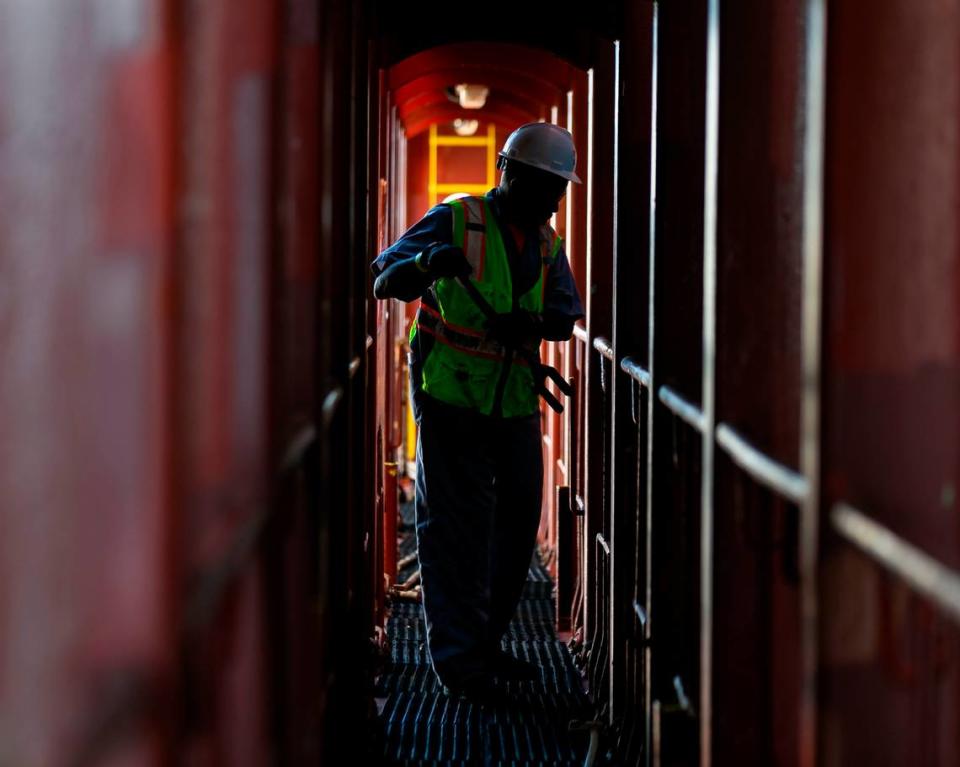
Former president of the Miami-Dade NAACP Ruban Roberts worries that opportunities like those provided by Local 1416 won’t live on. He points to efforts by former Miami-Dade Mayor and current congressman Carlos Gimenez to outsource bus routes and bypass the largely Black Miami-Dade transportation union.
“This pathway to gaining wealth and sustaining wealth is becoming narrower and narrower,” Roberts said. “If we don’t pay attention these avenues for folks who want to work hard and contribute in a positive way to their community will be long gone.”
Last year, a sign appeared pasted to the sidewalk outside the union hall honoring Local 1416’s history of raising wages and advancing workers’ rights, as part of a digital guided tour of the neighborhood by the group “Going Overtown.” Dunn hopes for a permanent historical marker for the longshoremen.
“I’d like to see them emblazon something on the wall that’s permanent, that’s what I’d like to see,” said Dunn. “People are walking on it, spitting on it. That is not where you put a marker for a union that did so much for Black people.”

